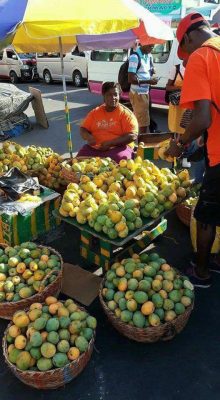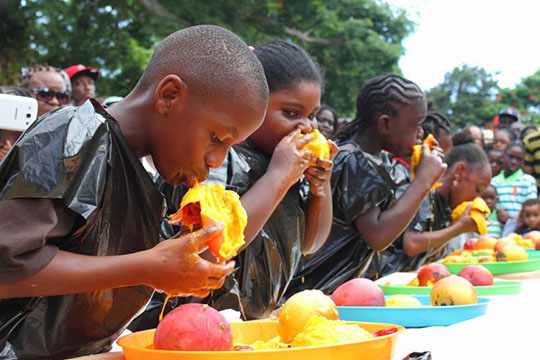If you think that the mango ranks at the very top of the list of the world’s most revered fruits then the available evidence suggests that you have a pretty strong case for so believing. And if you think that July is the month in which the mango enjoys its highest global profile then, unquestionably, you have a water tight case.
Just over a week ago the Caribbean island of Nevis wound up its July 4 -7 Mango and Food Festival, the fifth such annual event and once which the pundits say is quickly becoming a serious contender for one of the spots among regional food festivals.
Nevis may not, customarily, be one of the more talked-about Caribbean islands but its reported 44 varieties of mango are highly prized for their texture and flavour. During the season of the Festival, particularly, they reportedly trigger an enhanced level of culinary creativity among celebrity and local chefs who take their particular picks from amongst the flavors to turn out everything from soups and salsas, to marinades, sauces, cocktails and fabulous desserts. As is the case across the region, however, locals are quite content to eat the mangoes fresh off the trees – ’fresh pick’ as we say in Guyana.

The four-day Nevis mango ‘affair’ kicks off a bewildering array of menus at local restaurants and tourist resorts. Guests from all over the island reserve their spots well ahead of time for lunches and dinners that feature the mango. This month, the chefs from Nevis resorts and restaurants along with other chefs competed in a mango ‘cook-off’ on Sunday, July 7, at the island’s Oualie Beach for the final celebration and festival attended by live music and food in abundance.
But the Nevis affair is just the tip of the iceberg insofar as the international celebration of one of the world’s most eaten fruits is concerned. Beginning in 1987, the Indian capital of New Delhi has been staging a two-day International Mango Festival annually under the auspices of the Delhi Tourism and Transportation Development Corp. Ltd., the stated purpose of this event being to increase the awareness of domestic mango among the people.
Reports from New Delhi indicate that this year more than fifty mango farmers from across India travelled to New Delhi to showcase the varieties of mangoes and the various ways in which they can be prepared. Setting aside the opportunity to taste a few of the varieties of mango available in India, attendees at the Festival also enjoy an array of mango shakes, mango pickle and other mango-based eatables. The New Delhi event also reportedly features quiz competitions related to mangoes and cultural programmes built around the theme of the mango.
During the Delhi Mango Festival much emphasis is also placed on the health benefits of the mango, so that the event also features mango-based nutrition – related products advertised by vendors in the related fields. Our health-conscious readers should be made aware that mango is a low-calorie fruit and is high in fiber. It is also a great source of vitamins A and C and also contains folate, B6, iron, and a little calcium, zinc, and vitamin E. Mangoes are also a good source of antioxidants.
Next Tuesday, July 22nd is National Mango Day. The event will pass quietly in Guyana but in India National Mango Day is celebrated in tribute to a fruit which, reportedly, has been cultivated in that country for at least 5,000 years. It reportedly traveled to Southeast Asia between the 5th and 4th centuries BC. In the 10th Century AD cultivation began in East Africa. The mango is the national fruit of India, Pakistan, and the Philippines and India and China are the two largest suppliers of mango globally. An estimated 550 different varieties of mango are believed to grow in mostly tropical countries. The mango is said to be related to the cashew and the pistachio.
While the United States is the most lucrative mango market in the hemisphere, as is the case with other agricultural crops, Caribbean territories only benefit from a modest share of that market. Most of the mangoes sold in the U.S. come from Mexico, Peru, Ecuador, Brazil, Guatemala, and Haiti.
One of the most consumed fresh fruit anywhere in the world, extensive marketing and production is believed to take place in 115 countries over a global area of 5.41 million hectares. Annual global production is estimated at around 42.66 million metric tons (MMT) with India producing 18 million tons (MMT) of the total global production. Mexico and the United States are the main mango exporter and importer, respectively.





